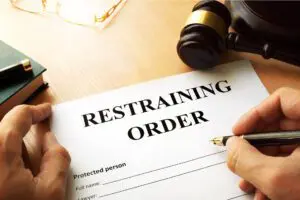Short answer: No.
In California, you cannot obtain a restraining order “for no reason.” Courts require legally sufficient grounds supported by evidence before issuing any restraining order. Personal disagreements, retaliation, or vague fear—without qualifying conduct—are not enough.
This article explains who can request a restraining order, what reasons qualify under California law, and why courts refuse orders without cause.
What Does “For No Reason” Mean in Legal Terms?
When people ask whether they can get a restraining order for no reason, they usually mean:
- No physical violence occurred
- No police report exists
- The conflict is emotional, verbal, or situational
Legally, “no reason” means no conduct that meets statutory requirements. California courts do not issue restraining orders based on discomfort, anger, or relationship conflict alone.
Valid Legal Reasons to Obtain a Restraining Order
A judge may issue a restraining order only if the petitioner proves conduct such as:
- Physical abuse or attempted physical harm
- Threats of violence
- Stalking or repeated unwanted following
- Harassment that causes substantial emotional distress
- Sexual assault
- Destruction of property tied to intimidation
The court must find that the conduct creates a reasonable fear of harm, not just subjective anxiety.
Evidence Required to Support a Restraining Order
Courts rely on evidence, not assumptions. Common forms include:
- Text messages, emails, or voicemails containing threats
- Police or incident reports
- Medical records or photographs of injuries
- Witness declarations
- Call logs or documentation of repeated contact
Without credible evidence, a court is unlikely to grant an order.
Types of Restraining Orders and Eligibility
California recognizes several restraining order categories, each with specific eligibility rules:
- Domestic Violence Restraining Orders (DVROs) – spouses, former partners, family members
- Civil Harassment Restraining Orders (CHROs) – neighbors, coworkers, acquaintances
- Elder Abuse Restraining Orders
- Workplace Violence Restraining Orders
If the relationship or conduct does not fit the statute, the request may be denied—even if the petitioner feels unsafe.
Can Someone Lie or File a Restraining Order Without Cause?
Anyone can file a request, but courts do not grant restraining orders automatically.
Judges carefully scrutinize requests that appear:
- Retaliatory
- Strategic in divorce or custody disputes
- Unsupported by evidence
- Exaggerated or inconsistent
If the legal threshold is not met, the court will deny the request.
Temporary and Emergency Orders
Temporary Restraining Orders (TROs)
A judge may issue a TRO based on preliminary information to provide short-term protection. However, a TRO does not guarantee a permanent restraining order.
At the hearing, the petitioner must still prove the case.
Emergency Protective Orders (EPOs)
EPOs are issued in urgent situations, often through law enforcement. They are short-lived and expire unless extended by the court.
Key Takeaway
You cannot get a restraining order for no reason in California.
Courts require legally sufficient grounds and evidence before restricting another person’s rights. Requests based on personal conflict, retaliation, or unsupported claims are often denied.
For guidance on whether your situation qualifies, consulting an experienced Los Angeles domestic violence attorney at Duncan Family Law can help ensure your request is evaluated and handled properly under California law.
FAQs
Can you get a restraining order for no reason?
No. A valid legal reason supported by evidence is required.
Can a restraining order be granted without physical violence?
Yes, if there are threats, stalking, or qualifying harassment—but evidence is still required.
Does filing guarantee approval?
No. The court decides based on evidence and legal standards.





